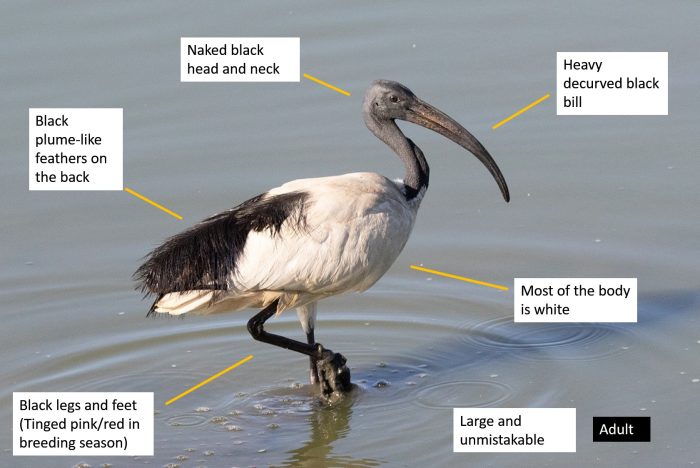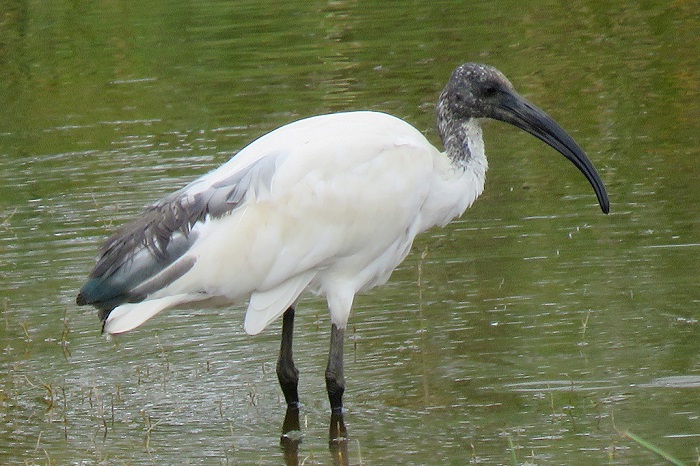Cover image: African Sacred Ibis by Malcolm Robinson– Darvill Bird Sanctuary, KwaZulu-Natal – BirdPix No. 249235
Identification
The African Sacred Ibis is a large, conspicuous and unmistakable species. The sexes are alike.

Dinokeng Game Reserve, Gauteng
Photo by Lance Robinson
Immatures are similar in appearance to the adults but have some white feathering on the neck.

Bonamanzi Game Reserve, KwaZulu-Natal
Photo by Michael McCarthy
In flight shows white underwings and a distinct black trailing edge to the flight feathers.

Near Carnarvon, Northern Cape
Photo by Ryan Tippett
Status and Distribution
The African Sacred Ibis is a common to very common resident, although some populations may be nomadic within southern Africa. It is widely distributed in sub-Saharan Africa, Madagascar and the Middle East. It is found virtually throughout southern Africa but is less common and localised in arid areas, including much of Namibia, central Botswana and the Northern Cape.
It is an adaptable species and has benefited from human activities. It is not considered threatened.

Details for map interpretation can be found here.
Habitat
The habitat spectrum of this species is very varied and includes grasslands, cultivated lands, sewage works, sports fields, offshore islands, coastal lagoons, abattoirs and rubbish dumps. Throughout its range it is most commonly associated with freshwater habitats, especially marshes.
It breeds in colonies at many different types of sites, in trees and bushes, on the ground and among rocks on islands.

Dikhololo Resort, North West
Photo by Werner Van Goethem
Behaviour
It is often seen in ones and twos but it is mostly a gregarious species and flocks can number into the hundreds.
It forages by probing with its bill in mud or shallow water, walking slowly with purposeful steps while scanning around for food. It frequently scavenges at farmyards, dairies, piggeries, abattoirs, rubbish dumps and seabird breeding colonies on islands.

Near Malmesbury, Western Cape
Photo by Les Underhill
Its diet is highly varied. Live prey taken includes frogs, small reptiles, rodents, nestling birds, molluscs, insects, crustaceans and other invertebrates. Scavenged food includes bird and crocodile eggs, offal, carrion and human waste.
It roosts in trees, reedbeds or on islands, and typically flies to and from roosts in V – formation.
It breeds in colonies; these are often mixed colonies including other species such as storks, herons, egrets, spoonbills and cormorants. Breeding is recorded throughout the year in southern Africa but mostly takes place in summer in the east and during winter in the west.
The nest is a simple platform of sticks lined with leaves and grass. Nests are most frequently placed in trees but also in bushes or on the ground.
Two to five eggs are laid per clutch. The eggs are dull white, sometimes with a blueish tinge and usually with some red-brown spots. The incubation period lasts for around 29 days and incubation duties are shared by both parents. Chicks are altricial and the nestlings are ready to leave the nest after 14 to 21 days and can fly after 35 days or so. Young birds are fed by both parents.

Muzi Pan, KwaZulu-Natal
Photo by Ryan Tippett
Further Resources for the African Sacred Ibis
Species text adapted from the first Southern African Bird Atlas Project (SABAP1), 1997.
The use of photographs by Garth Aiston, Gerald Wingate, Gregg Darling, Michael Wright, Phillip Nieuwoudt, Tino Herselman and Zenobia van Dyk is acknowledged.
Virtual Museum (BirdPix > Search VM > By Scientific or Common Name).
Other common names: Heilige ibis (Afrikaans); umXwagele (Zulu); Lehalanyane (South Sotho); Heilige Ibis (Dutch); Ibis sacré (French); Heiliger Ibis (German); Ibis-sagrado (Portuguese)
Recommended citation format: Tippett RM 2023. African Sacred Ibis Threskiornis aethiopicus. Biodiversity and Development Institute. Available online at http://thebdi.org/2023/05/17/african-sacred-ibis-threskiornis-aethiopicus/

Elands Bay, Western Cape
Photo by Ryan Tippett

